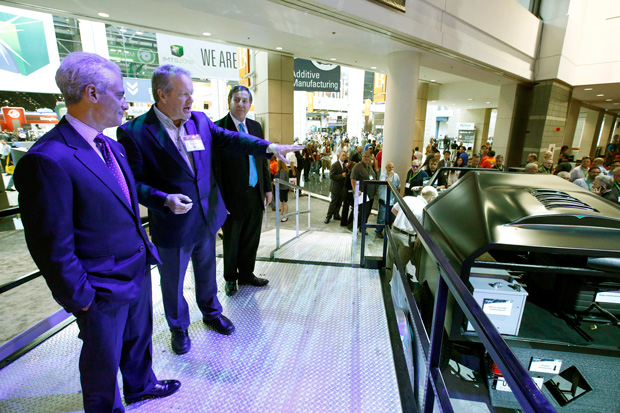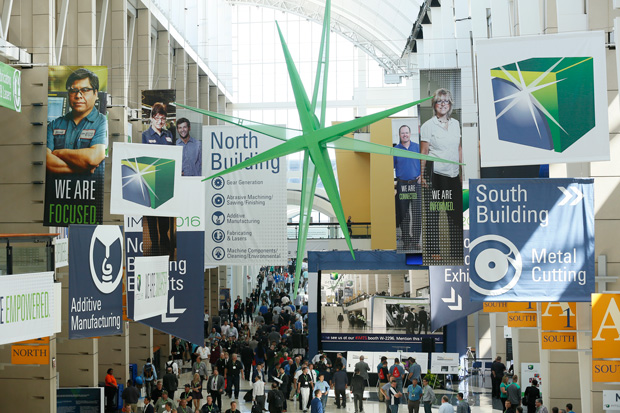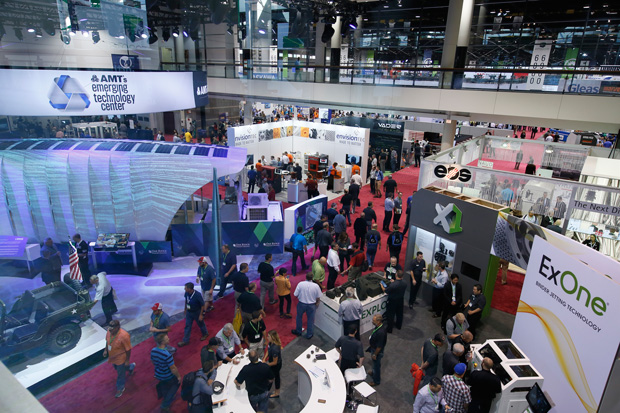IMTS 2016 Showcases Promise

This year’s IMTS had over 115,000 attendees. Image courtesy of IMTS.
September 23, 2016
The International Manufacturing Technology Show (IMTS) is the mecca for all technology related to manufacturing. From September 12-15, over 115,000 attendees saw the latest and greatest from 2,407 exhibiting companies and discussed the current state of the industry at McCormick Place in Chicago.
“Today, even in the face of global headwinds, there are 828,000 more Americans in manufacturing jobs than just six years ago,” said Penny Pritzker, U.S. Secretary of Commerce, in her opening keynote. “The number of factories in the United States has started to increase again.”
In her speech, Pritzker noted that while manufacturing has grown from the recession, the industry is reaching a turning point. “We must engage the next generation of workers and excite our youth about the potential of a career in manufacturing. We must change the perception of manufacturing [from] outdated factories filled with line jobs,” she said.
However, with the emergence of Industrial Internet of Things (IIoT) initiatives, large-scale additive manufacturing and advancing applications, it’s hard to believe that the next generation of manufacturing will remain stagnant.
Additive Manufacturing Takes the Stage
Among the traditional manufacturing machines, software and automation devices, this year’s show featured an Additive Manufacturing (AM) Pavilion. “Additive manufacturing is a reality for the industrial marketplace. It’s not fully mature, but the technology has progressed far enough that if you’re ignoring 3D printing at IMTS 2016, you’re making a big mistake,” says David Burns, founder and principal of Global Business Advisory Services LLC.
Leaders in the AM sector displayed their latest initiatives to bring the technology a more viable option for large-scale production. Stratasys’ Infinite Build and Robot Composite demonstrators were up and running to showcase potential applications in aerospace and automotive.
With the Infinite Build Demonstrator, users are not limited by a build height, and can make parts significantly larger than before. With the Robot Composite Demonstrator, a printhead is attached to a multi-axis robot arm, expanding the angle from which the machine can build the Z-axis.
From 3D Systems, the company announced a new partnership with CAD company PTC to bring engineers a step closer to a complete design-to-print workflow. “Almost everything is sliding down a slope to digital-physical convergence,” said Jim Heppelmann, president and CEO of PTC. “3D printing is important to PTC because it’s one of the first boundary-crossing technologies from the digital into the physical world.”
The goal is to develop a tighter integration between 3D Systems software and Creo for a less-intensive design for 3D printing process. Additionally, the company also announced 3DXpert, an all-in-one software for metal 3D printing.
The Softer Side of Manufacturing
Aside from all the new hardware, CAD and CAM software was also on display from Autodesk, Mastercam, ESPRIT and a handful of others.
Autodesk’s new portfolio of manufacturing solutions includes technology integrations from past acquisitions of Delcam and HSMWorks. “Autodesk’s new 2017 CAM products are designed to help our customers learn, improve and master advanced manufacturing techniques that ultimately lead to better designed and functional products being brought to market more quickly and efficiently,” said Mark Forth, manager of Manufacturing Industry Strategy at Autodesk.
Attendees could also see the latest offerings for Fusion—such as capabilities from the recent acquisition of NEi Nastran and a peek at the company’s “codeless IoT platform.”
Mastercam showcased its updated 2017 release, with improved functionality and an updated Microsoft Office ribbon-style interface. This setup, according to the company, lets users find capabilities much easier and helps address the learning curve for CAM software.
From ESPRIT, the newest release of its CAM software, ProfitTurning, was on display. Using a physics-based cutting engine, the software is suited for reducing cycle times for engineers, machinists and industrialists.
“By employing trochoidal turning and controlled engagement techniques, the ProfitTurning toolpath reduces vibration and residual stresses, which in turn makes it particularly well-suited to thin walls or hard materials, especially super alloys. The net result is significantly reduced cycle times and maximized productivity,” said Ivan Kristic, R&D director of Product and Engineering at DP.
What’s Next in Tech
At the last IMTS in 2014, technology company Local Motors turned heads with its 3D-printed Strati car. While there was no print and assembly effort on the show floor this year, Local Motors did demonstrate Olli, a self-driving, AI-connected vehicle. The mobility component was available to provide attendees and provide information about the show through its connection to IBM Watson.
 Local Motor’s CEO and co-founder Jay Rogers (at right) welcomes visitors to Olli, a self-driving at the heart of the IMTS Ride Experience, located in C Hall of the North Building. Image courtesy of IMTS.
Local Motor’s CEO and co-founder Jay Rogers (at right) welcomes visitors to Olli, a self-driving at the heart of the IMTS Ride Experience, located in C Hall of the North Building. Image courtesy of IMTS.“The real drivers [behind autonomous vehicles] are the element of convenience. We use vehicles for transportation to get us around, [so] it’s really about getting from point A to point B and about the productivity during that time. So it’s useful to get on board something that’ll take care of the trip for you,” said Alex Fiechter, head of Product development at Local Motors.
Additionally, an Emerging Technology Center (ETC) featured projects from Oak Ridge National Laboratory and EOS North America. The organization’s projects demonstrated advances in additive manufacturing in fields such as energy, transportation and medicine.
“The ETC is world-renowned for showcasing projects and disruptive technologies that were previously known to only a few. We want the ETC to challenge preconceived notions of how manufacturing performs at its best,” said Peter R. Eelman, vice president, Exhibitions & Business Development at AMT.
 Chicago mayor Rahm Emanuel (left) received a tour of AMT’s Emerging Technology Center on Wednesday. Dr. Craig Blue (center), CEO of the Institute for Advanced Composites Manufacturing Innovation, describes how this hybrid utility vehicle can be wirelessly charged. Image courtesy of IMTS.
Chicago mayor Rahm Emanuel (left) received a tour of AMT’s Emerging Technology Center on Wednesday. Dr. Craig Blue (center), CEO of the Institute for Advanced Composites Manufacturing Innovation, describes how this hybrid utility vehicle can be wirelessly charged. Image courtesy of IMTS.With major product announcements and technological advancements on display, attendees of this year’s IMTS surely saw that the manufacturing industry is entering a new chapter. Demonstrating a host of advancements from hardware to industrial intelligence, the manufacturing sector is shaping up to be a different kind of industry—with lots of opportunity for innovation.
Subscribe to our FREE magazine, FREE email newsletters or both!
About the Author
Jess Lulka is a former associate editor for Digital Engineering. Contact her via [email protected].
Follow DE







